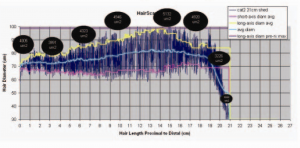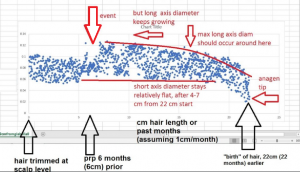As hairs grow longer, they lose their thickness
The first picture is from Dr. Robert Haber’s magnified study of a hair scan of a single hair on one of Dr. Paul Cotterill’s female patients. It revealed that hair thickness and shape changes as the hair grows longer. The measurement scan below demonstrates the changes in this 21 cm long female single hair. Telogen is on the left (the end of the hair cycle) and the start of anagen on the right (where the new hair started to grow out from the scalp) showing how the shaft thickness and bulk builds as the hair starts growing and is widest at about 14-15 cm (about 15 months into the growth of the hair). It is clear that the hair thickness is greatest at the 14 -15 cm. length of the hair in this female patient. Dr. Haber told me that this was a normal female hair and she had no symptoms of a hair disorder. Clearly we need to understand the various conditions that this technology is capable of showing us as hairs are evaluated with regard to many different treatments.
In the second chart, a hair shaft thickness is shown over its length and the researchers, Dr. Michael Rabin and Dr. Robert Haber show the impact of an event that occurred in this particular patient’s hair (which had grown out for 22 months) but the event occurred 16 months into its growth cycle. The large arrow shows pointing down shows the timing of the event and it this case it was a PRP treatment 6 months ‘in time’ prior to the hair being cut off at its base at 22 months growth. Note this hair’s emergence from the scalp (beginning of anagen on the right) and the point where PRP was administered 16 months into its growth cycle (shown with large red arrow pointing down). It is easy to see the point where the event occurred, but interpreting it is another story. Is this a good result or a bad one? Was the hair ‘healthier’ after the PRP injection. The graph suggests it was less thick, but maybe it was a healthier hair?
This is exciting research to me because now after seeing it, I would want to know the impact of drugs like minoxidil on a normal terminal hair, (we now believe that there is no impact), the impact of finasteride on a miniaturizing hair (we now believe it increases the hair shaft thickness) and the growth of a single long hair with the patient on finasteride over time (does the benefit build slowly or is it a one time hit?). I just loved the creativity of these clinical researchers in producing a tool that can expand our knowledge in what is still, at times, a ‘Black Art’ for, the treatment of hair loss. . (Ref: http://neoangels.net/ishrsboston/hairscan.pdf)



Reader Comments0
Share this entry
Leave a Comment
Want to join the discussion? Feel free to contribute! Note: We do not tolerate offensive language or personal attacks to other readers. Marketing links or commercial advertisements will be deleted.